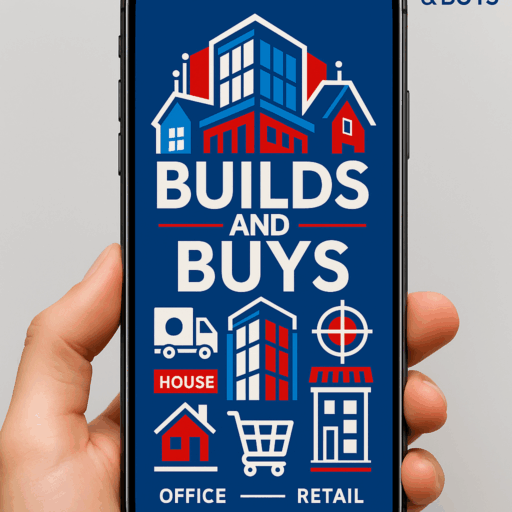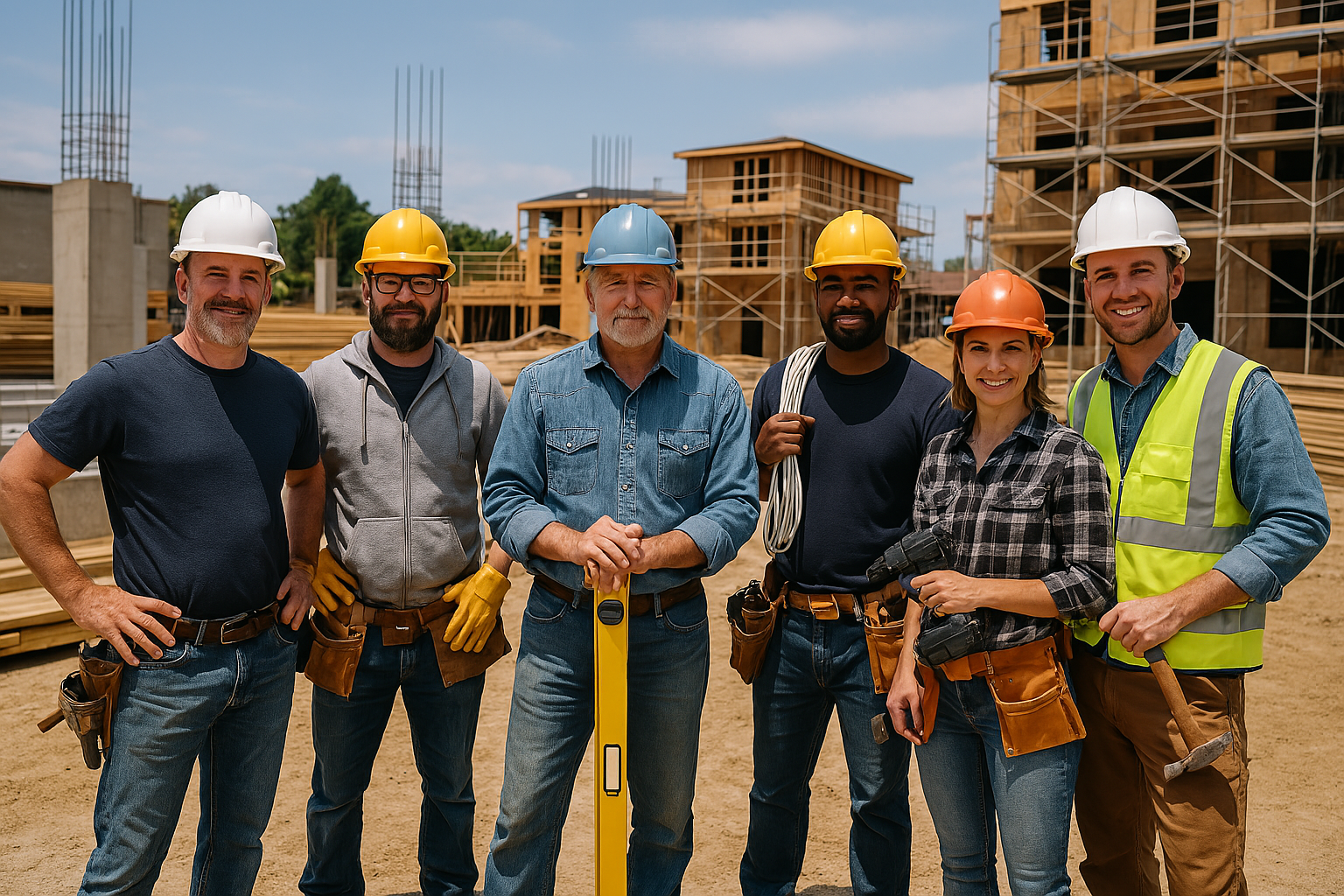
Check out our app!
Explore more features on mobile.
Interior Finishes: Strategic Implementation Guide for Real Estate Investors
Interior finishes represent the visible elements that define a property’s aesthetic appeal, functionality, and perceived value. For real estate investors, these final touches significantly impact marketability, tenant attraction, and potential return on investment. According to the National Association of Home Builders, interior finishes typically account for 20-30% of a renovation budget but can influence up to 70% of a buyer’s or renter’s emotional response to a property.
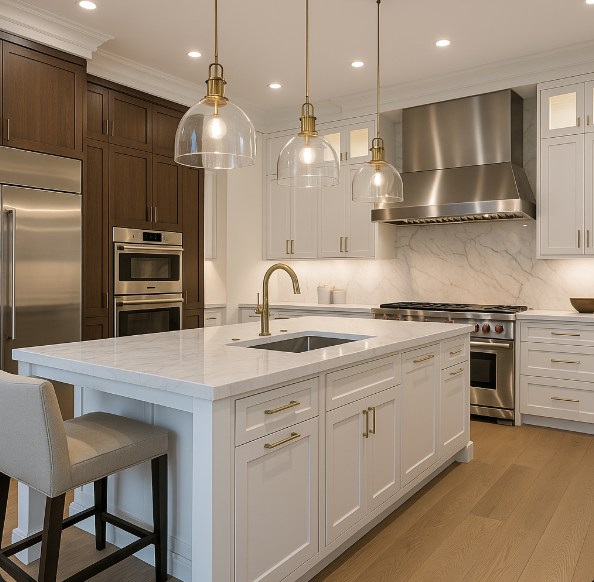
Strategic Planning for Interior Finishes
Effective interior finish planning balances aesthetic appeal, durability, budget constraints, and target market expectations. According to Remodeling Magazine’s Cost vs. Value Report, thoughtfully selected interior finishes can significantly impact both property marketability and financial returns.
Key strategic considerations for real estate investors include:
- Market alignment – Matching finish quality and style to target market expectations
- Durability requirements – Balancing upfront costs with longevity and maintenance needs
- Design cohesion – Creating a consistent aesthetic throughout the property
- Budget allocation – Strategically investing in high-impact areas
- Installation sequencing – Planning the correct order of operations for efficient implementation
Market-Specific Considerations
The National Association of Realtors emphasizes that finish selections should align with both property type and target demographic:
- Rental properties – Prioritize durability, neutral design, and easy maintenance
- Entry-level homes – Focus on contemporary mainstream finishes at moderate price points
- Mid-market properties – Balance quality and trend-awareness with reasonable costs
- Luxury properties – Invest in premium materials, unique design elements, and superior craftsmanship
- Senior housing – Emphasize safety features, accessibility, and easy-care surfaces
Research from Zillow indicates that properties with finishes properly aligned to their target market sell up to 30 days faster and command 3-7% higher prices compared to properties with misaligned finishes.
Strategic Budgeting Approach
The Interior Design Society recommends a strategic approach to budget allocation for optimal return on investment:
- High-impact zones – Allocate larger portions of the budget to areas with maximum visual impact (kitchens, master baths, entryways)
- Visual hierarchy – Identify focal points for premium materials with more economical choices in secondary areas
- Cost-per-impression calculation – Evaluate each finish based on visibility and importance to target buyers/renters
- Material quantity analysis – Consider the square footage requirements when selecting premium materials
- Labor intensity factor – Account for installation complexity when comparing material options
Investment Perspective: The 60-30-10 Rule
The American Society of Interior Designers recommends the 60-30-10 budget allocation approach for optimal returns:
- 60% of budget – Allocated to foundational elements with large visual impact (flooring, major cabinetry, primary wall treatments)
- 30% of budget – Directed toward secondary elements that complement the foundation (countertops, quality lighting fixtures, interior doors)
- 10% of budget – Reserved for distinctive accent elements that create memorable impressions (backsplashes, statement lighting, architectural details)
This balanced approach ensures sufficient investment in fundamental elements while allowing for strategic accents that differentiate the property in the marketplace.
Phasing and Timeline Planning
Interior finish installation requires careful sequencing to prevent damage and minimize rework. The National Association of the Remodeling Industry recommends the following sequence:
- Texture and paint ceilings – Complete overhead work first to prevent damage to other finishes
- Install trim and millwork – Complete door casings, baseboards, crown molding, and built-ins
- Paint walls and trim – Complete all painting before floor installation
- Install cabinetry – Set base cabinetry and fixed vertical elements
- Install countertops – After cabinetry is verified level and secure
- Complete hard surface flooring – Tile, hardwood, luxury vinyl, and other hard surfaces
- Install fixtures and hardware – Plumbing fixtures, cabinet hardware, light fixtures
- Install carpet/soft flooring – Complete soft floor coverings as final step before cleaning
Flooring Options and Selection Criteria
Flooring represents one of the largest interior finish investments and significantly impacts both aesthetic appeal and property functionality. According to the World Floor Covering Association, flooring choices should balance appearance, durability, maintenance requirements, and installation considerations.
| Flooring Type | Typical Cost Range | Expected Lifespan | Best Applications | Key Considerations |
|---|---|---|---|---|
| Luxury Vinyl Plank/Tile | $3-$7 per sq ft installed | 10-20 years | Rental properties, high-traffic areas, wet locations | Water-resistant, low maintenance, wear layer thickness impacts durability |
| Engineered Hardwood | $7-$15 per sq ft installed | 15-30 years | Living areas, dining rooms, bedrooms, mid to high-end properties | Veneer thickness affects refinishing potential, moderate moisture resistance |
| Solid Hardwood | $8-$18 per sq ft installed | 25+ years | Premium properties, main living areas, bedrooms | Multiple refinishing potential, susceptible to moisture damage |
| Ceramic/Porcelain Tile | $8-$20 per sq ft installed | 30+ years | Bathrooms, kitchens, entryways, high-moisture areas | Extremely durable, waterproof, higher installation complexity |
| Laminate | $2-$5 per sq ft installed | 7-15 years | Budget renovations, low-traffic areas, short-term holds | Susceptible to moisture damage, not refinishable, easy installation |
| Carpet | $3-$10 per sq ft installed | 5-15 years | Bedrooms, family rooms, basements, sound dampening | Face weight and density affect durability, stain resistance important |
| Natural Stone | $15-$40 per sq ft installed | Lifetime (with proper maintenance) | Luxury properties, statement areas, high-value locations | Requires sealing, some types susceptible to etching, elegant appearance |
| Polished Concrete | $3-$12 per sq ft installed | 20+ years | Modern/industrial spaces, heavy-use areas, warm climates | Can be cold underfoot, requires quality concrete substrate, low maintenance |
Note: Cost ranges represent national averages as of 2023 and may vary by region. Source: Floor Covering News, HomeAdvisor, Remodeling Magazine
Selection Criteria for Investment Properties
The National Apartment Association provides data showing that flooring selection significantly impacts both tenant attraction and retention. Key selection factors include:
- Traffic patterns – Matching durability to expected foot traffic intensity
- Moisture exposure – Selecting appropriate water resistance for each area
- Maintenance requirements – Considering ongoing care needs and tenant capability
- Acoustic properties – Evaluating sound transmission in multi-level or shared-wall properties
- Installation considerations – Accounting for subfloor condition and height transitions
- Replacement logistics – Planning for eventual replacement ease and downtime
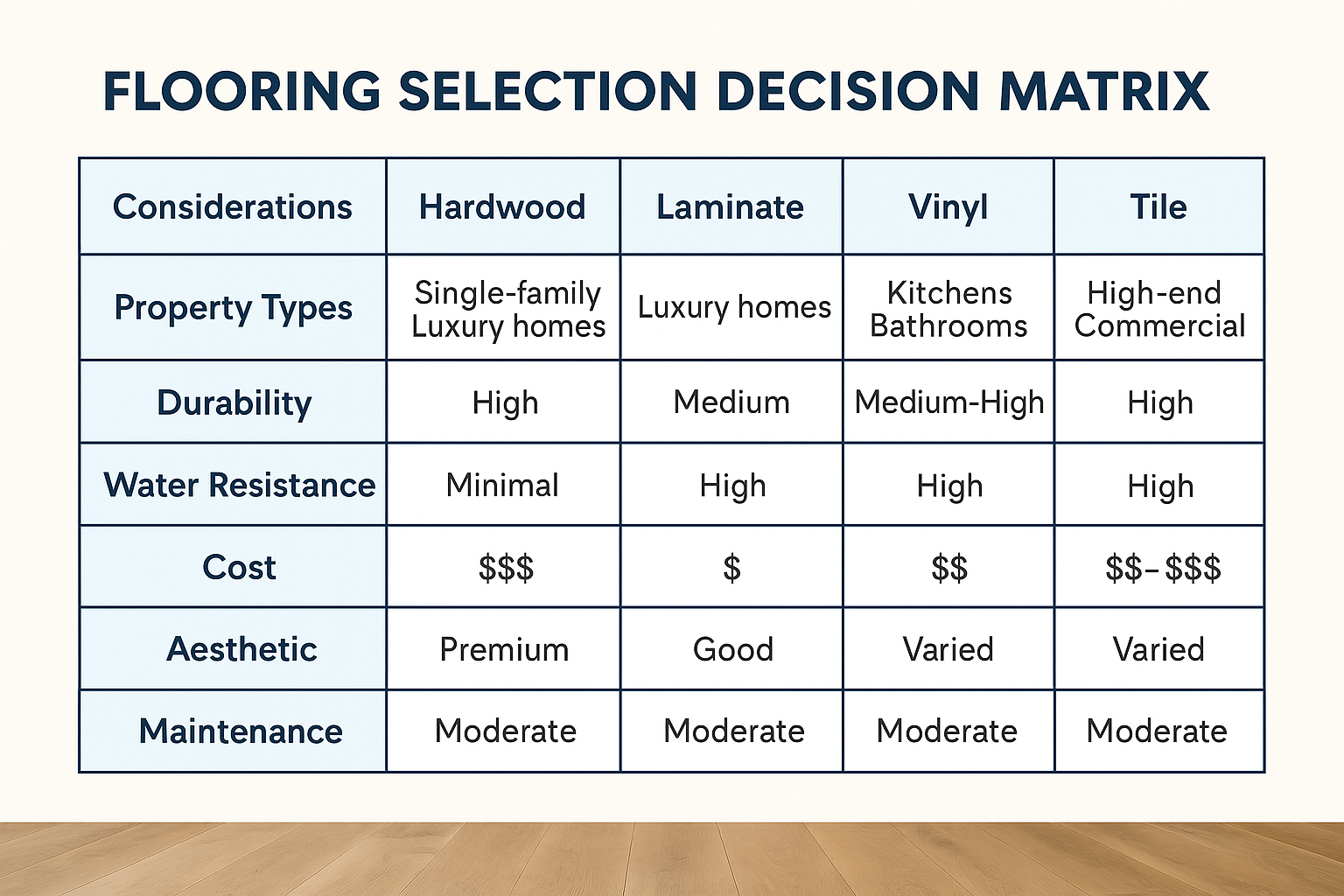
Installation Quality Factors
The National Wood Flooring Association emphasizes that installation quality significantly affects performance and longevity. Critical installation considerations include:
- Subfloor preparation – Ensuring level, clean, and structurally sound substrate
- Moisture testing – Verifying acceptable moisture levels in both subfloor and flooring materials
- Acclimation periods – Allowing materials to adjust to installation environment
- Expansion provisions – Accommodating natural material movement
- Transition details – Properly addressing material changes between rooms
- Pattern considerations – Thoughtful layout planning for aesthetic appeal and waste minimization
Current Flooring Trends
The Floor Covering Institute identifies several trends impacting property marketability and value perception:
- Wider planks – 5″ to 9″ widths for hardwood and luxury vinyl creating more spacious feel
- Mixed-width installations – Combining plank sizes for custom, high-end appearance
- Waterproof solutions – Growing preference for moisture-resistant flooring throughout properties
- Lighter wood tones – Shift toward blond, natural, and whitewashed finishes from darker stains
- Large-format tile – 12″x24″ and larger sizes with minimal grout lines for contemporary appeal
- Sustainable materials – Increasing value placed on environmentally responsible options
Wall Finishes, Paint, and Treatments
Wall finishes create the backdrop for all other interior elements and significantly impact both perceived space quality and overall aesthetic impression. According to the Painting and Decorating Contractors of America, wall treatments represent one of the most cost-effective ways to transform a property’s appearance and marketability.
Paint Selection and Application
Paint remains the most common wall finish due to its versatility, relatively low cost, and ease of application. The American Society of Interior Designers notes several key paint considerations:
- Paint quality tiers – Investment implications:
- Builder-grade: $15-25/gallon, suitable for short-term rentals and quick flips
- Mid-grade: $30-45/gallon, appropriate for most rental properties
- Premium: $50-80/gallon, recommended for owner-occupied and luxury properties
- Finish selection – Appropriate sheen by application:
- Flat/Matte: Hides imperfections, best for ceilings and low-traffic areas
- Eggshell/Satin: Balances washability with softness, ideal for most living spaces
- Semi-gloss: Highly washable, appropriate for kitchens, bathrooms, and trim
- Gloss: Maximum durability, typically used for doors, cabinets, and specialized applications
- Color strategy – Creating cohesive schemes:
- Neutral palette: Maximizes market appeal for sales and general rentals
- Accent walls: Creates visual interest with minimal investment
- Color psychology: Utilizing colors that evoke specific emotional responses
Research from Zillow indicates that certain paint colors can significantly impact property values. Neutral light grays and beiges in main living areas typically yield 1-3% higher sale prices, while white kitchens and light blue bathrooms show similar positive effects.
Alternative Wall Treatments
Beyond basic paint, various wall treatments can add character, texture, and functionality. The Wallcoverings Association provides data on several popular options:
| Wall Treatment | Typical Cost Range | Best Applications | Investment Considerations |
|---|---|---|---|
| Wallpaper | $3-$15 per sq ft installed | Accent walls, powder rooms, dining rooms | Higher initial cost, potentially dated, removal considerations |
| Textured Paint | $2-$4 per sq ft | Living areas, entry ways, accent features | Hides wall imperfections, adds dimension, moderate cost |
| Wainscoting/Paneling | $7-$40 per sq ft installed | Dining rooms, entryways, hallways | Adds architectural interest, protects walls, higher installation complexity |
| Tile | $10-$30 per sq ft installed | Bathrooms, kitchen backsplashes, shower surrounds | Durable, waterproof, higher cost but excellent longevity |
| Shiplap/Wood Planks | $5-$15 per sq ft installed | Feature walls, coastal designs, rustic aesthetics | Trending but potentially date-specific, adds texture and warmth |
| Stone Veneer | $15-$50 per sq ft installed | Fireplaces, accent walls, exterior-interior transitions | High-end appearance, significant visual impact, long-term investment |
Source: Wallcoverings Association, HomeAdvisor, Remodeling Magazine (2023 data)
Surface Preparation Fundamentals
The Painting and Decorating Contractors of America emphasizes that proper surface preparation significantly impacts both appearance and longevity of wall finishes:
- Drywall finishing quality – Ensuring proper level of finish for intended wall treatment
- Surface cleaning – Removing dust, grease, and contaminants before applying finishes
- Primer selection – Matching primer type to both substrate and finish coat
- Repair methods – Properly addressing holes, cracks, and surface defects
- Moisture mitigation – Addressing any underlying moisture issues before applying finishes
Critical Quality Warning
According to the National Association of Home Builders, inadequate surface preparation accounts for approximately 80% of premature paint and wall covering failures. Addressing surface imperfections and proper priming typically adds only 15-20% to the total painting budget but can double the effective lifespan of the finish.
Key risk mitigation strategy: Always budget for proper surface preparation, including repairs, sanding, and appropriate primers. This relatively small investment significantly reduces callback issues and premature deterioration.
Current Wall Treatment Trends
The Interior Design Society identifies several trending wall finish approaches with investment implications:
- Feature walls – Single-wall treatments in bold colors or textures creating focal points
- Large-scale patterns – Oversized wallpaper patterns and murals for dramatic effect
- Textural elements – Three-dimensional surfaces adding tactile interest
- Color blocking – Geometric paint applications creating visual structure
- Natural materials – Wood, stone, and organic textures bringing warmth and authenticity
- Removable options – Peel-and-stick products offering flexibility and tenant customization
Cabinetry, Countertops, and Built-Ins
Cabinetry and countertops represent significant investment areas that dramatically impact both functionality and aesthetic appeal. According to the National Kitchen and Bath Association (NKBA), these components typically account for 40-50% of kitchen renovation budgets and 25-30% of bathroom renovation costs.
Cabinetry Options and Selection Criteria
The Cabinet Manufacturers Association identifies several key considerations when selecting cabinetry for investment properties:
| Cabinet Type | Typical Cost Range | Best Applications | Durability Factors |
|---|---|---|---|
| Stock Cabinets | $80-$180 per linear foot | Entry-level rentals, budget renovations, short-term holds | Basic construction, limited finishes, 7-15 year lifespan |
| Semi-Custom | $150-$350 per linear foot | Mid-market properties, standard rentals, long-term investments | Better construction, more finish options, 15-25 year lifespan |
| Custom Cabinets | $300-$800+ per linear foot | Luxury properties, owner-occupied, high-end market positioning | Premium construction, unlimited options, 25+ year lifespan |
| Ready-to-Assemble | $50-$150 per linear foot | Budget renovations, temporary solutions, DIY installations | Variable quality, lower durability, 5-10 year lifespan |
| Refaced Cabinets | $100-$250 per linear foot | Updates to structurally sound cabinets, value improvements | Depends on base cabinet condition, 7-15 additional years |
Source: National Kitchen and Bath Association, Cabinetry Installation Contractors Association (2023 data)
Cabinet construction features that impact durability and investment value include:
- Box construction – Plywood boxes offer superior durability compared to particleboard
- Drawer construction – Dovetail joints and solid wood drawers provide better longevity
- Door styles – Shaker and flat-panel designs offer timeless appeal and easier maintenance
- Hardware quality – Soft-close hinges and full-extension drawer glides enhance functionality
- Finish durability – Factory-applied finishes typically outperform field-applied options
Countertop Material Comparison
The Marble Institute of America provides comparative data on countertop materials based on durability, maintenance, and investment considerations:
| Countertop Material | Typical Cost Range | Durability Factors | Maintenance Considerations |
|---|---|---|---|
| Laminate | $15-$40 per sq ft installed | Susceptible to scratches, burns, moisture damage | Easy cleaning, not repairable if damaged |
| Solid Surface | $40-$75 per sq ft installed | Resistant to stains, seamless appearance, repairable | Moderate scratch resistance, can be damaged by heat |
| Granite | $50-$100 per sq ft installed | Very durable, heat-resistant, unique patterns | Requires periodic sealing, can chip if impacted |
| Quartz (Engineered Stone) | $55-$120 per sq ft installed | Extremely durable, non-porous, consistent appearance | No sealing required, can be damaged by extreme heat |
| Marble | $60-$150 per sq ft installed | Luxury appearance, vulnerable to etching and staining | High maintenance, requires frequent sealing, shows wear |
| Butcher Block/Wood | $40-$100 per sq ft installed | Warm appearance, can be refinished, scratches easily | Requires regular oiling, vulnerable to water damage |
| Porcelain Slab | $60-$125 per sq ft installed | Extremely durable, heat/stain resistant, lightweight | Low maintenance, growing popularity, good longevity |
Source: Marble Institute of America, National Kitchen and Bath Association (2023 data)
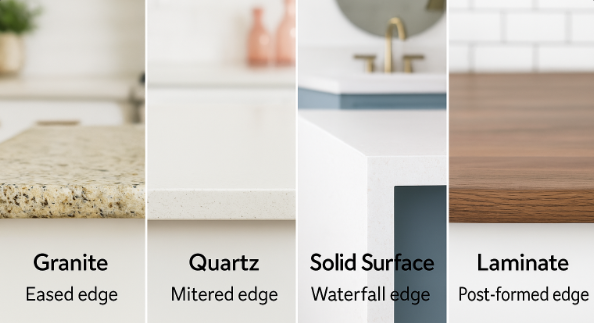
Built-Ins and Storage Solutions
Strategic built-in features can significantly enhance property functionality and market appeal. The National Association of Home Builders identifies several high-value built-in elements:
- Kitchen pantry organization – Pull-out shelving, dedicated storage zones
- Bathroom storage solutions – Medicine cabinets, linen storage, vanity organization
- Mudroom/entry features – Bench seating, coat hooks, shoe storage
- Bedroom closet systems – Customized organization with hanging space, shelving, and drawers
- Home office components – Built-in desks, shelving, and technology integration
- Entertainment centers – Media wall systems with component storage and display areas
According to remodeling industry data, thoughtfully designed built-ins typically return 70-85% of their investment cost while significantly enhancing property marketability and reducing time-on-market by 15-20%.
Investment Perspective: Kitchen and Bath Focus
The National Association of Realtors’ annual “Cost vs. Value” report consistently shows that kitchen and bathroom improvements deliver the highest returns among interior renovation projects. Strategic approaches for these spaces include:
- Minor kitchen updates: Cabinet refacing, new countertops, and updated hardware typically return 75-85% of investment cost while dramatically improving market appeal
- Bathroom refreshes: New vanities, countertops, fixtures, and flooring generally return 70-80% of costs while addressing spaces that significantly influence buyer/renter decisions
- Targeted luxury: Concentrating premium materials in smaller areas (like kitchen islands or bathroom vanities) provides visual impact while controlling overall costs
- Layout preservation: Working within existing layouts typically delivers better ROI than major reconfigurations requiring plumbing and electrical changes
Trim, Doors, and Hardware
Trim elements, interior doors, and hardware details create the finishing framework that defines a property’s character and quality perception. According to the Architectural Woodwork Institute, these components significantly impact both aesthetic cohesion and perceived craftsmanship.
Trim Profiles and Applications
The Moulding and Millwork Producers Association provides data showing that trim selections dramatically influence architectural style and perceived value:
- Baseboard options – Height and profile considerations:
- Entry-level: 3-4″ height with simple profile ($1.00-$2.50 per linear foot)
- Mid-range: 5-6″ height with moderate detail ($2.50-$5.00 per linear foot)
- Premium: 7″+ height with substantial profile ($5.00-$12.00+ per linear foot)
- Casing selections – Door and window trim options:
- Basic: 2¼-2½” width with minimal detail ($0.80-$2.00 per linear foot)
- Enhanced: 3-3½” width with moderate detail ($2.00-$4.00 per linear foot)
- Luxury: 3½-4½”+ width with significant detail ($4.00-$10.00+ per linear foot)
- Crown moulding impact – Ceiling transition options:
- Standard: 2-3″ simple crown ($1.50-$3.00 per linear foot)
- Enhanced: 3-5″ with moderate detail ($3.00-$6.00 per linear foot)
- Premium: 5-8″+ with multiple pieces ($6.00-$15.00+ per linear foot)
Note: Costs reflect material only; installation typically adds $1.00-$4.00 per linear foot depending on complexity. Source: Moulding and Millwork Producers Association (2023)
Research from the National Association of Home Builders indicates that upgrading from basic to enhanced trim typically adds $2,000-$5,000 to a 2,000 sq ft home but can increase perceived value by $5,000-$12,000, representing a significant return on investment.
Interior Door Selection
Interior doors significantly impact both privacy and design continuity. The Window and Door Manufacturers Association identifies several key considerations:
- Door construction types – Performance and cost implications:
- Hollow core: Lightweight, economical ($50-$150 per door), limited sound blocking
- Solid core: Substantial feel, better sound control ($150-$300 per door)
- Solid wood: Premium appearance and performance ($300-$800+ per door)
- Door styles – Design and architectural considerations:
- Flush doors: Clean, contemporary appearance, versatile application
- Panel doors: Traditional character, varying panel configurations
- Glass insert options: Light transmission while maintaining privacy
- Door height impact – Ceiling height considerations:
- Standard: 6’8″ height (80″) for typical residential applications
- Enhanced: 7’0″ height (84″) for transitional ceiling heights
- Premium: 8’0″ height (96″) for elevated ceiling heights and luxury positioning
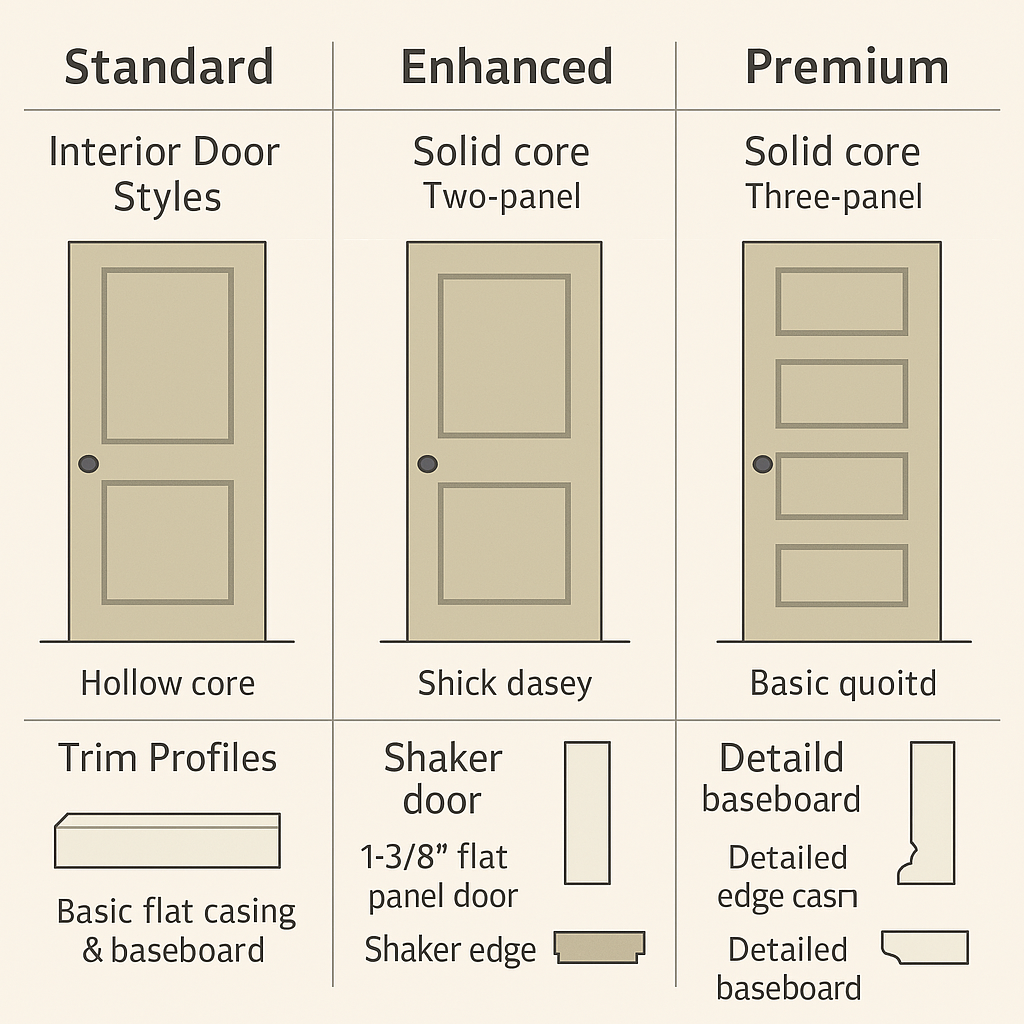
[Image: Visual comparison of interior door styles and trim profiles across different quality tiers]
Hardware Selections
Hardware elements provide both functional necessity and design enhancement. The Builders Hardware Manufacturers Association notes several investment considerations:
- Door hardware tiers – Quality and cost implications:
- Builder grade: $15-$40 per set, basic functionality, shorter lifespan
- Mid-grade: $40-$100 per set, better mechanics, improved appearance
- Premium grade: $100-$300+ per set, substantial feel, lifetime warranties
- Cabinet hardware impact – Design and functionality factors:
- Economy: $2-$5 per piece, basic styles and finishes
- Standard: $5-$15 per piece, improved design and durability
- Luxury: $15-$50+ per piece, designer styles, premium materials
- Finish consistency – Creating cohesive appearance:
- Matching or coordinating finishes throughout the property
- Consideration of durability factors for different applications
- Alignment with overall design scheme and target market preferences
Market research from the Real Estate Staging Association indicates that updated hardware represents one of the most cost-effective property improvements, with coordination of finishes and styles across a property increasing perceived value by 2-3% at minimal cost.
Installation Quality Considerations
The Finishing Contractors Association emphasizes that installation quality significantly impacts both appearance and functionality:
- Precision mitering – Proper corner joints for trim elements
- Nail set techniques – Properly countersunk fasteners and filled holes
- Caulking application – Clean seams between trim and walls
- Door hanging precision – Proper clearances, swing, and hardware alignment
- Paint preparation – Proper sanding, priming, and finish application
- Reveal consistency – Uniform spacing and alignment throughout the property
Professional installation typically adds 100-150% to material costs but delivers significantly better results that enhance property value and reduce maintenance issues.
Builds and Buys Approach: Interior Finishes Framework
At Builds and Buys, we’ve developed a systematic approach to interior finish selection and implementation that maximizes investment return while ensuring proper alignment with property goals:
Step-by-Step Builds: Interior Finishes Strategy
Our comprehensive approach to new construction and renovation projects:
- Market alignment analysis – Matching finish specifications to target market expectations
- Material hierarchy planning – Strategic allocation of premium materials in high-impact areas
- Design cohesion framework – Creating consistent aesthetic throughout the property
- Contractor qualification protocol – Selecting installation professionals with proven expertise
- Quality verification standards – Implementing inspection processes at critical milestones
Step-by-Step Buys: Interior Evaluation Framework
For investors evaluating existing properties, our assessment framework provides critical insights:
- Finish condition assessment – Evaluating current state and remaining useful life
- Market alignment gap analysis – Identifying discrepancies between current finishes and market expectations
- High-impact upgrade identification – Pinpointing improvements with maximum value enhancement
- Renovation scope development – Creating prioritized improvement plans
- Finish value enhancement – Strategies for maximizing perceived value with minimal investment
Step-by-Step Invest: Financial Optimization
Our investment strategies help allocate finish budgets for maximum financial performance:
- ROI-driven material selection – Identifying finishes with optimal return on investment
- Visual impact maximization – Creating perceived value through strategic material placement
- Durability-to-cost ratio analysis – Balancing longevity with initial investment
- Marketability enhancement metrics – Quantifying how specific finishes impact time-on-market
- Maintenance cost projection – Considering long-term care requirements in material selection
Quality Assurance and Maintenance Protocols
Implementing systematic quality verification and maintenance procedures ensures that interior finishes deliver their intended value and performance over time. The National Association of Home Builders and various trade organizations recommend comprehensive inspection approaches for different finish elements.
Flooring Installation Inspection Checklist
- ☐ Subfloor Preparation
- ☐ Surface properly cleaned and prepared
- ☐ Floor level within required tolerances
- ☐ Appropriate underlayment installed
- ☐ Moisture barriers in place where required
- ☐ Subfloor moisture content verified within acceptable range
- ☐ Material Installation
- ☐ Proper pattern/layout with minimum waste
- ☐ Appropriate expansion gaps maintained
- ☐ Correct fastening or adhesive application
- ☐ Pattern alignment and consistency
- ☐ Transitions properly installed at material changes
- ☐ Detail Completion
- ☐ Edge details properly finished
- ☐ Baseboards and trim installed with proper spacing
- ☐ Floor meets vertical surfaces cleanly
- ☐ Doorway transitions properly installed
- ☐ Surface clean and ready for use
Wall Finish Quality Verification
- ☐ Surface Preparation
- ☐ Walls properly primed for finish material
- ☐ Surface imperfections addressed
- ☐ Appropriate texture applied if specified
- ☐ Corners square and properly finished
- ☐ Moisture issues addressed before finishing
- ☐ Paint Application
- ☐ Proper number of coats applied
- ☐ Consistent coverage without visible roller marks
- ☐ Crisp lines at color transitions
- ☐ Uniform sheen across surfaces
- ☐ No bleed-through or visible repairs
- ☐ Alternative Wall Treatments
- ☐ Wallpaper properly aligned with minimal seams
- ☐ Wall treatments securely adhered
- ☐ Tile installations with consistent grout lines
- ☐ Specialty finishes properly executed
- ☐ Transitions between materials handled appropriately
Cabinetry and Countertop Verification
- ☐ Cabinet Installation
- ☐ Cabinets level, plumb, and square
- ☐ Securely fastened to wall/floor
- ☐ Doors and drawers properly aligned
- ☐ Hardware installed with consistent positioning
- ☐ Proper operation of all moving parts
- ☐ Countertop Installation
- ☐ Level across entire surface
- ☐ Properly secured to base cabinets
- ☐ Seams minimized and properly finished
- ☐ Edge details consistent and complete
- ☐ Sink and fixture cutouts properly executed
- ☐ Finish Details
- ☐ Toe kicks properly installed
- ☐ End panels and fillers correctly sized and installed
- ☐ Crown molding or top details properly finished
- ☐ Caulking clean and complete at wall intersections
- ☐ Surfaces cleaned and free of construction debris
Trim and Door Quality Assurance
- ☐ Trim Installation
- ☐ Mitered corners tight and flush
- ☐ Properly secured to wall surfaces
- ☐ Consistent reveal between trim and adjacent surfaces
- ☐ Nail holes filled and sanded
- ☐ Caulked appropriately at wall intersections
- ☐ Door Installation
- ☐ Door plumb in frame with consistent gaps
- ☐ Proper operation without binding
- ☐ Hardware installed and functioning correctly
- ☐ Latches engage properly with strike plates
- ☐ Door stops installed at appropriate locations
- ☐ Finish Quality
- ☐ Paint or stain evenly applied
- ☐ No visible brush marks or drips
- ☐ Hardware installed after finishing
- ☐ All surfaces cleaned after installation
- ☐ Touch-ups completed as needed
Maintenance Guidelines by Finish Type
Proper maintenance extends the life of interior finishes and preserves property value. The National Association of Home Builders recommends these care protocols:
- Flooring maintenance – Material-specific requirements:
- Hardwood: Clean with manufacturer-approved products, avoid excess moisture, recoat every 3-5 years
- Luxury vinyl: Regular sweeping/vacuuming, damp mopping with mild cleaner, avoid harsh chemicals
- Tile: Clean with appropriate pH-balanced cleaners, periodic grout sealing, avoid acidic products
- Carpet: Regular vacuuming, prompt stain treatment, professional cleaning every 12-18 months
- Wall finish care – Proper cleaning and touch-up:
- Painted surfaces: Clean with mild solutions, maintain touch-up paint, address damage promptly
- Wallcoverings: Follow manufacturer cleaning guidelines, avoid moisture at seams
- Specialty finishes: Use specific care products recommended by installer or manufacturer
- Cabinetry and countertop care – Surface-specific protocols:
- Wood cabinets: Clean with appropriate cleaners, avoid excess moisture, periodic resealing
- Stone countertops: Reseal according to schedule, use stone-specific cleaners, promptly address spills
- Manufactured surfaces: Follow manufacturer guidelines for cleaning and stain removal
- Trim and door maintenance – Preserving appearance and function:
- Painted trim: Clean gently, touch up as needed, address caulk failures
- Door hardware: Periodic tightening of screws, lubrication of moving parts
- Door operation: Adjust hinges as needed, maintain proper latching
Providing tenants or buyers with property-specific maintenance guidelines significantly improves finish longevity and reduces replacement frequency by 30-50% according to property management industry data.
Discover more essential real estate investment strategies with our comprehensive guides on Step-by-Step Builds, Step-by-Step Buys, and Step-by-Step Invest.
Your Tools
Access your tools to manage tasks, update your profile, and track your progress.
Collaboration Feed
Engage with others, share ideas, and find inspiration in the Collaboration Feed.
